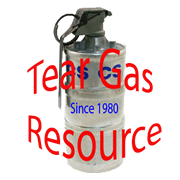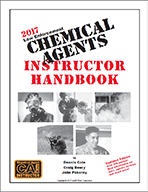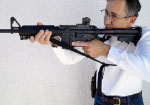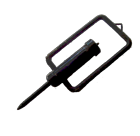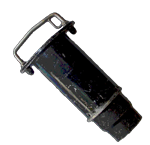The goal of introducing non-lethal chemical agents inside of a structure is to force a barricaded subject to evacuate the building. How we get those non-lethal chemical agents into the structure varies. The most common ways of introducing agent are: Breaking windows and throwing in hand delivered devices like the tri-chamber grenade or BurnSafe, using a GasRam or similar device or shooting special barricade penetrating rounds commonly called “Ferret Rounds".
This article will encompass the pros and cons of using the barricade penetrating round called a “Ferret Round”. These rounds are available in 37mm, 40mm & 12 gauge. They come with liquid chemicals and dry powder chemicals. You can get them loaded with CS, OC or CN. The most commonly used “Ferret Rounds" are loaded with CS.
The word “Ferret Round” is a trademarked name owned by DefTec. Most barricade penetrating projectiles are commonly called “Ferret Rounds" because they were marketed by the AAI Corporation for many years before other manufacturers started making and selling them. So people just commonly call all the rounds that are liquid filled barricade penetrating, “Ferret Rounds".
The “Ferret Rounds” are frangible projectiles filled with chemical agent either liquid or dry powder. Spin stabilization from fins and barrel rifling can afford a safe standoff distance with some accuracy.
The “Ferret Round” is designed to penetrate barriers, such as windows, particleboard doors, and interior walls. Upon impacting the barrier, the nose cone ruptures and instantaneously delivers the agent payload inside of a structure.
If it is a liquid filled projectile the plastic shell penetrates a barrier. As the shell penetrates it cracks then the liquid is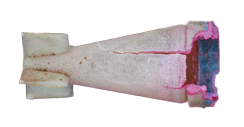 released inside the structure at approximately 450 (37mm and 40mm) to 1,000 (12 gauge) feet per second. At these speeds the liquid vaporizes as it hits the air and causes a mist to form in the space. If it is a powder filled projectile the same dynamics happens, releasing pulverized particles of dry powder into the space.
released inside the structure at approximately 450 (37mm and 40mm) to 1,000 (12 gauge) feet per second. At these speeds the liquid vaporizes as it hits the air and causes a mist to form in the space. If it is a powder filled projectile the same dynamics happens, releasing pulverized particles of dry powder into the space.
“Ferret Rounds” are made to penetrate light barriers, such as windows, hollow core doors, particleboard doors and interior walls or wooden barricades. The U.S. Department of Justice has established three levels of barricade penetrating projectiles. They are:
Type I-Light-Duty Penetrator
- A munition that is not designed to penetrate barriers as a primary mission, but may do so in some circumstances.
Type II-Single-Thickness Penetrator
- A munition that penetrates single-thickness barrier materials. Dissemination occurs after or while penetrating materials such as single-glazed windows, plywood sheathing, or plasterboard.
Type III-General-Purpose Penetrator
- A munition that penetrates multiple layers of lightweight construction material. Dissemination of the tear gas occurs after the penetration of barriers such as hollow-core doors, residential partitions, or non-masonry exterior walls, and double- or triple-glazed windows.
Most of the “Ferret Rounds” sold today would be a Type II penetrator. The original AAI 12 gauge “Ferret Round” penetrated:
- ¾” plywood at 0-50 feet
- Hollow Core Door at 0-300 feet
- Auto Safety Glass at 0 to 100 feet
- Double-pane storm window & screen at 0 to 300 feet
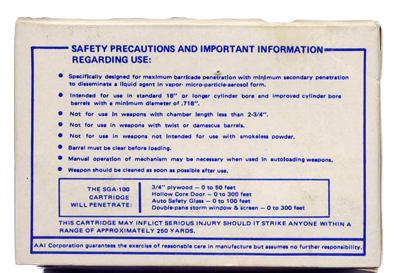
ADVANTAGES OF “FERRET ROUNDS”
Fast deployment
Accuracy
Easy to use can be fired from most duty shotguns
Can be fired from behind cover
Good Penetration
Non-Burning - Disperses on impact
Visibility - Rounds produce little smoke or cloud
Persistency - Contamination clean-up
DISADVANTAGES OF “FERRET ROUNDS”
May cause suspects to think he is being shot at
Can be fatal
Round must strike an object to disperse
Limited amount of agent
No smoke - No psychological effect
Easy to block the release of agent into a room
Agent does not always penetrate target area
Persistency leads to agent evacuation when windows broken
Dry power drops to ground quicker than aerosol
Carrier is carcinogenic (Methylene Chloride)
Fast Deployment – The 12 gauge rounds are the same size as a shotgun round. Patrol officers can easily carry with them “Ferret Round”s. They can easily be deployed from a standard patrol shotgun. The 37mm and 40mm rounds need a special launcher not readily available to most patrol officers so their use is limited to tactical teams. back
Accuracy - Because these rounds are fin stabilized they are fairly accurate up to 50 yards. There is a 90% probability of hitting a target staying in a 1 foot diameter at his range. A California Agency did a study with 12 gauge rounds trying to find the optimum firing distance and angle. They developed what is referred to as the 30-30 rule. They found that if you fire over a 30 degree angle the rounds tend to not penetrate. If you fire past 30 yards the rounds are inaccurate and tend not to penetrate. back
Easy to Use - The 12 gauge ferret round can be fired from any smooth bore, non-choked, 12 gauge shot gun. Best to use a pump shot gun. An autoloader or gas operated shotgun will have to be hand cycled because the ferret round does not have enough gas discharged to cycle the action. The 37mm and 40mm versions are usually used in a single shot configuration. However, the rounds can be loaded into a drum launcher like the M-32 or the Arwen. Be sure to check that you have the right launcher for the rounds you purchase. All rounds and launchers are not compatible. back
Strike - The "Ferret Round" must strike a light barricade before it can deploy its contents. Failure to do that just means you have a high speed plastic bullet flying around.
Cover – The 50 yard distance allows officers to fire from behind available cover for a safer deployment. Be aware that when firing “Ferret Round”s they will leave a flame signature from your launcher. Fire and move to new cover would be a safe tactic. back
Penetration - The “Ferret Round” is designed to penetrate barriers, such as windows, particleboard doors, and interior walls. Upon impacting the barrier, the nose cone ruptures and instantaneously delivers the agent payload inside of a structure. Most of the “Ferret Round”s sold today would be a DOJ Type II penetrator. The original AAI 12 gauge “Ferret Round” penetrated:
- ¾” plywood at 0-50 feet
- Hollow Core Door at 0-300 feet
- Auto Safety Glass at 0 to 100 feet
- Double-pane storm window & screen at 0 to 300 feet
Test your brand rounds to determine penetration for your jurisdiction. back
Non Burning – The “Ferret Round” is a non-pyrotechnic round. It will not start a fire by itself. Upon impact it releases its contents which are also non-burning. In the siege of the Branch Dravidian Compound in Waco, Texas many people have accused the FBI of starting a fire with the “Ferret Round”. The best guess is that a round hit something like a candle which started the fire. In another case in Mississippi a “Ferret Round” was suspected of rupturing a gas line which lead to a fire. back
Visibility – The cloud formed by the liquid in a round vaporizing is invisible. This means that if you have to enter the building with your respirator on you will have unobstructed views as if there was no agent there. The downside to this is that you also can’t be sure that there is agent present. Compare this to a smoke filled environment where you have views obstructed by smoke but you know there is agent present. Liquid projectiles contain red dye to aid in shot placement. If you see the red on the outside of the window or door you will know your agent didn’t make it inside. back
Persistency – The aerosolized agent stays in the air for a long time. This allows for the suspect to continue breathing in the agent. The down side is that if you break a window or sliding glass door a weak to moderate wind will blow the agent out of the structure rapidly. Because you cannot see the agent you never know whether there is an effective amount of agent in the structure.
The dry powder settles to the ground more quickly than smoke or aerosol. However, whenever the suspect walks around he will make the agent airborne again.
Persistency is great for decontamination. A large fan will blow most of the agent out of the structure if the windows are opened. The fan will never get the entire amount of agent out. The dry powder is harder to remove with a fan. back
Psychological– The sound of weapons being fired to launch “Ferret Round”s may confuse a suspect thinking you are shooting at him. It may spark a reaction by the suspect. The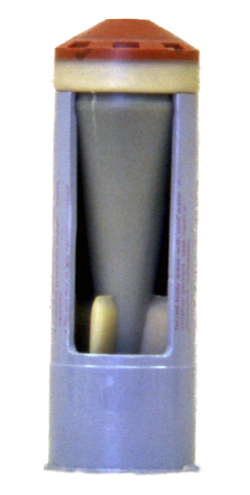 reaction may be positive, he surrenders, or it may be negative, he returns fire. The lack of a visible cloud can take away the psychological effect of panic by the suspect when they see the smoke. The opposite argument is that if the suspect feels the effects of the agent but doesn’t see the cloud he may panic more not knowing what is happening. back
reaction may be positive, he surrenders, or it may be negative, he returns fire. The lack of a visible cloud can take away the psychological effect of panic by the suspect when they see the smoke. The opposite argument is that if the suspect feels the effects of the agent but doesn’t see the cloud he may panic more not knowing what is happening. back
Can be fatal - When firing a "Ferret Round" make sure you fire them so they don’t unintentionally strike and kill a suspect or hostage. If they strike an individual the rounds could inflict a fatal wound. Most people teach to fire on an upward trajectory so that the rounds will lodge in the ceiling where most people are not located. back.
Limited Agent - The rounds carry very little agent. This low amount of agent can depress the psychological effects of the agent. Most agencies want a maximum first effect to get the suspect to panic. A smaller amount can condition his psychological response and make it more difficult to get him out. The flip side is, with less agent the decontamination is easier.
| Payloads with CS in grams | |||
| DefTec | ALS | CTS | |
| 12 gauge | .71 | 2 | 2.2 |
| 37mm | 8 | -- | 7.48 |
| 40mm | 8 | 12 | -- |
Easy to Block – It is simple to barricade windows with mattresses, heavy drapes, or any material that will catch the liquid from the Ferret Round. This prevents the liquid from aerosolizing and contaminating the structure. San Diego Sheriff’s Department studied this effect and published an article in the National Tactical Officers Association Magazine. (Click here to read) back
Does not always reach the intended target - If you are going to use “ferret round”s be aware of your position and the wind direction. If windows are going to be broken always break on the upwind side of the structure. That will allow the wind to keep the agent in the structure. If you hit a sliding glass door made of safety glass there is a chance that the entire window will shatter as designed and you will have a large opening to let agent out. If you go through a barricade and your round doesn’t immediately crack and release agent the round is likely to imbed itself in drywall releasing its agent into the porous drywall. This will keep the agent from becoming airborne and contaminating the structure. back
Carrier is Carcinogenic - Methylene chloride is a clear colorless liquid which has many uses as a solvent and degreasing agent. It is used as the solvent to dissolve solid CS for loading into the “Ferret Round” type delivery systems. Methylene chloride has a penetrating, ether-like, odor which is irritating at high concentrations. Inhalation of air containing methylene chloride in the range 500 - 1000 ppm can cause minimal anesthetic or narcotic effects. Progressively higher levels can cause dizziness and drunkenness, and still higher concentrations can cause cardiac arrhythmia, unconsciousness, and death. California OSHA states that 125ppm in a 15 minute period is all that should be tolerated. (Read More) The amounts used should not rise to dangerous levels. However, do not train in contaminated structures without a respirator. back
